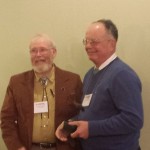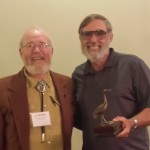George Archibald and Tom Stehn receive Jerome J. Pratt – Whooping Crane Conservation Awards
On April 17, 2012, at the North American Crane Workshop, WCCA Trustee Walt Sturgeon presented both George Archibald and Tom Stehn with Jerome J. Pratt Whooping Crane Awards. The award is a lifetime achievement award given to an individual or organization who, through exceptional achievement and dedicated service, have contributed significantly to the conservation and/or collective knowledge of the whooping crane.
George Archibald
 George Archibald is the award-winning co-founder of the International Crane Foundation. George’s vision was to protect the world’s crane species from extinction by establishing a captive breeding center. Under George’s direction, the Crane Foundation has grown from humble beginnings into an internationally known power house of crane research. He has collaborated with colleagues throughout the world to promote crane conservation and wetland preservation. Undeterred by political boundaries and current politics, George has used the bond shared by numerous peoples that cranes are sacred and deserve protection. George’s involvement with whooping cranes began with an imprinted female named Tex, who through artificial insemination was able to pass on her genes through her offspring. George has been a member of the Whooping Crane Recovery Team almost since its inception. His leadership at the Crane Foundation and his willingness to try alternate rearing and reintroduction techniques have proved to be beneficial to the captive breeding program and in bringing whooping cranes back to eastern North America.
George Archibald is the award-winning co-founder of the International Crane Foundation. George’s vision was to protect the world’s crane species from extinction by establishing a captive breeding center. Under George’s direction, the Crane Foundation has grown from humble beginnings into an internationally known power house of crane research. He has collaborated with colleagues throughout the world to promote crane conservation and wetland preservation. Undeterred by political boundaries and current politics, George has used the bond shared by numerous peoples that cranes are sacred and deserve protection. George’s involvement with whooping cranes began with an imprinted female named Tex, who through artificial insemination was able to pass on her genes through her offspring. George has been a member of the Whooping Crane Recovery Team almost since its inception. His leadership at the Crane Foundation and his willingness to try alternate rearing and reintroduction techniques have proved to be beneficial to the captive breeding program and in bringing whooping cranes back to eastern North America.
Thomas V. Stehn
 Since 1982, Thomas V. Stehn has monitored the whooping crane population wintering at and near the Aransas National Wildlife Refuge. Tom studied erosion of crane habitat along the Gulf Intracoastal Waterway which led to a large erosion control abatement project that was installed by the Army Corps of Engineers, US Fish and Wildlife Service and volunteers. This single project is responsible for the protection of hundreds of acres of Critical Habitat for the whooping crane. He developed an aerial census technique that provided annual population figures for the Aransas/Wood Buffalo population of whooping cranes. This one of a kind dataset has been instrumental in documenting overwinter mortality and is used by researchers around the globe to track the population. Tom became the U.S. Fish and Wildlife Service Whooping Crane Coordinator and co-chairman of the International Whooping Crane Recovery Team in 1998. As coordinator he has been deeply involved with all whooping crane issues, ranging from power line collisions to captive breeding. He is one of the authors of the International Recovery Plan for the Whooping Crane (2007). Tom retired in September, 2011, after 32 years of service with the Federal Government.
Since 1982, Thomas V. Stehn has monitored the whooping crane population wintering at and near the Aransas National Wildlife Refuge. Tom studied erosion of crane habitat along the Gulf Intracoastal Waterway which led to a large erosion control abatement project that was installed by the Army Corps of Engineers, US Fish and Wildlife Service and volunteers. This single project is responsible for the protection of hundreds of acres of Critical Habitat for the whooping crane. He developed an aerial census technique that provided annual population figures for the Aransas/Wood Buffalo population of whooping cranes. This one of a kind dataset has been instrumental in documenting overwinter mortality and is used by researchers around the globe to track the population. Tom became the U.S. Fish and Wildlife Service Whooping Crane Coordinator and co-chairman of the International Whooping Crane Recovery Team in 1998. As coordinator he has been deeply involved with all whooping crane issues, ranging from power line collisions to captive breeding. He is one of the authors of the International Recovery Plan for the Whooping Crane (2007). Tom retired in September, 2011, after 32 years of service with the Federal Government.
The Whooping Crane Conservation Association congratulates both George and Tom for their contributions on behalf of whooping cranes.

